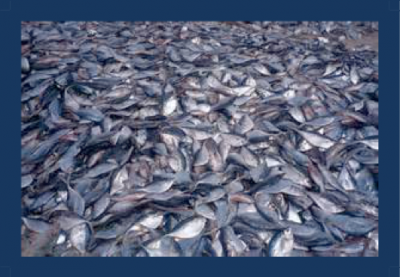|

No worries - there will be plenty left for future generations
Like you, I am puzzled by what “sustainable use” means, though sustainable utilisation of natural resources remains the central pillar for wildlife conservation put forward by organizations like WWF, IUCN, CITES, UNEP, FAO, etc.
Let’s have a look at some of the most prevalent definitions.
The IUCN says:
“a) Use of wild living resources, if sustainable, is an important conservation tool because the social and economic benefits derived from such use provide incentives for people to conserve them;
b) When using wild living resources, people should seek to minimize losses of biological diversity;
c) Enhancing the sustainability of uses of wild living resources involves an ongoing process of improved management of those resources;
d) Such management should be adaptive, incorporating monitoring and the ability to modify management to take account of risk and uncertainty.”
The FAO says:
“… maintain and, where possible, enhance the productive capacity of the natural resource base as a whole, and the regenerative capacity of renewable resources, without disrupting the functioning of basic ecological cycles and natural balances, destroying the socio-cultural attributes of rural communities, or contaminating the environment.”
UNEP says:
“… the use of resources and the environment today [that] does not compromise their use in the future.”
WWF says:
“… [meeting] the needs of the present generation without compromising the ability of future generations to meet their needs. Sustainability is based upon three components: economic growth, social progress and environmental protection.”
I could go on with other examples, but you get the picture. It is basically about using natural resources today without compromising the possibility of future use. The definitions share key concepts like the long-term environmental, social and economic viability of activities and their ability to deliver quantity and quality outputs now and for generations to come.
That all sounds like common sense, but have such “highfalutin” promises about “sustainability” actually made a difference? After all, we have supposedly been “sustainably” fishing for decades and all we see is fish stocks declining. Trophy hunters have been “sustainably” hunting wildlife in Africa for decades, and all we see is more and more hunting concession becoming depopulated. We have supposedly been “sustainably” utilising timber for years and years and all we see is dramatically shrinking global forests.
I would put it to you that we should subject the empty concept of “sustainable” resource use to task and ask questions whenever someone says they are using natural resources in a “sustainable fashion”.
- For example – there is NO means by which to measure if any activity is indeed “sustainable”. All we have is some, perhaps deliberately, vague expression about “future generations”. That is complete nonsense, as we, in this generation, are destroying natural resources at a rate never seen before. The way the world population is growing means that use of natural resource use will only increase in the future. Real sustainability means that we should not use resources beyond their ability to recover. Bit of a problem when we are rapidly cutting down trees that took hundreds of years to grow?
- For example – “sustainable use” is largely determined by quotas determining “sustainable offtake”. Those quotas – as for fish – are largely politically determined, negotiated, and manipulated. I’ll go out on a limb and say that science is hardly ever used to evaluate “sustainability”, and even then manipulated by “government” and similar vested interest panels of scientists.
- For example – if we trust in “sustainable use” then there should be penalties given to “unsustainable use”. That very rarely happens – as we are again stymied by a definition of “sustainable use”. So far, the best we can do to define “unsustainable use” is to call it “illegal wildlife trafficking” and even then, the penalties for those caught are more than often laughable compared to the destruction wrought.
- For example – again referring to fisheries, governments often set “quotas” for commercially valuable fish like tunas, cod, herring, etc. This is supposed to enable “sustainable use” of those species, but ignores massive destruction of other fish species considered “by-catch”. In addition, fishery is an environmentally hugely destructive activity not only because trawlers scour the ocean bottoms but also contribute yearly to the already 640,000 TONS of abandoned nylon nets floating around the ocean – each net will last for an expected 600 years. There is no consideration of the level of environmental destruction of such so-called “sustainable” activities, as there is no means to factor in negative consequences of “sustainable use”.
- For example – as mentioned, “sustainable use” mostly ignores all side effects of sustainable activities like pollution, deforestation, soil erosion, depletion of water resources, and any concept of ethics or animal welfare. In addition, “sustainable use” does not incorporate climate change predictions.
- For example – “sustainable use” is an empty term as it is based on a complete ignorance of actual stocks of natural resources. The assessment of “stocks” often depends on computer models and extrapolations and should be delivered together with “confidence limits” and precautionary statements about the reliability of estimates. Thus, there can be no assumption that the “quotas” assigned are in any way realistic. Models and extrapolations are put forward without consequences, but resulting quotas based on a lack of actual data can be highly detrimental. We have no idea of how many male lions there are in Africa, but based on various extrapolations and vested interest “counts” African governments happily assign yearly quotas for trophy hunting.
In other words, sustainable use is an empty concept that in practice translates to little more than a politically correct cover for sustained abuse. There is a strong need to refine and redefine “sustainable use” – and get rid of the nonsense that phrase has spawned. I would suggest a shift to a practice that integrates the concept of “responsible” use with a built-in requirement of layers of precautionary measures.
|




